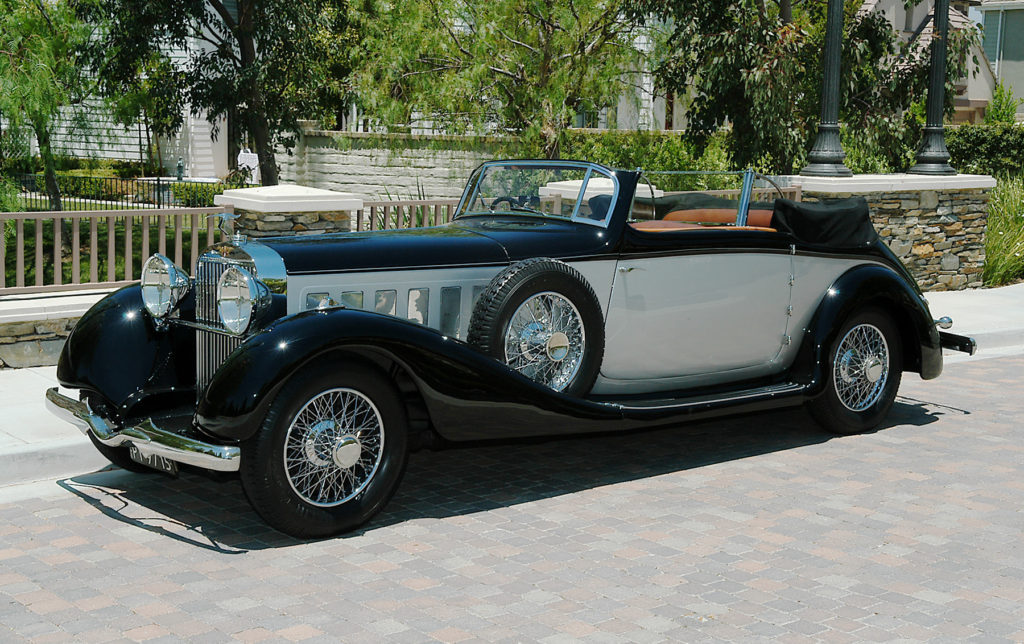In the sector of vintage vehicles, some treasures stand out for their iconoclastic design, extraordinary engineering, and a wealthy historic lineage—every thread contributing to their coveted popularity amongst discerning creditors. The 1933 Hispano-Suiza J12 Cabriolet is one such masterpiece. With an impeccable document that marries energy, opulence, and a sprint of Art Deco grandeur, this car embodies the zenith of the automobile international during its time. And now, poised to captivate lovers and traders alike, the imminent auction of the Hispano-Suiza J12 Cabriolet is stirring excitement in automobile circles for what’s expected to be a high-stakes affair.
For those attracted to the allure of best motoring, this relic of automobile exotica represents more than mere equipment. It prompts us to reflect on the craftsmanship of a bygone technology—a time while each vehicle become a bespoke assertion, intricately designed to reflect the individuality of its proprietor. In anticipation of the upcoming public sale, we’re going to unpack the importance of the Hispano-Suiza J12 Cabriolet, delving into its records, overall performance, and the cultural imprint that maintains to shape the luxurious automobile landscape. Whether you’re a pro collector or an aficionado with a burgeoning ardour, the tale of this legend on wheels is certain to pique your hobby.

Delving into the Vintage Luxe of the Hispano-Suiza J12 Cabriolets
Transition back to the early twentieth century—Spain, a land famend for artisans and visionaries who lent their craft to create the Hispano-Suiza marque. The J12, born of this rich legacy, made its debut in 1931 at the Paris Motor Show and changed into met with immediately acclaim. A marque hailing from aeronautical origins, it was no coincidence that the J12 changed into named for the Hispano-Suiza V-12 plane engine, a feat of electricity and precision revered the world over.
A Glimpse into Epochal Design
The J12 Cabriolet chassis was crafted to host custom coachwork—a canvas for the maximum prominent design homes of the time. Art Deco impacts are visible within the car’s lines and information, with every perspective and curve meticulously fashioned to exude sophistication. Notably, this version’s four-pace manual gearbox changed into mated to a powerful 9.5-liter V-12 engine, marking the J12 as a excursion de force in engineering excellence.
A Royal Association
Among the limited cohort of J12 Cabriolets, the model slated for auction garnered a prestigious history. Previously in the possession of European nobility, its ownership pedigree is a testament to the car’s royal appeal. Such regal provenance often adds an ethereal quality to a vintage car’s value, injecting a dash of glamour that money can’t typically buy.
Mechanically Marvelous: The J12 Cabriolet’s Ode to Performance
Beyond its ornate exterior and esteemed ownership, the J12 Cabriolet commands respect for its under-the-hood prowess. Even against contemporary benchmarks, the 1933 Hispano-Suiza J12 performance figures remain impressive, a nod to the fastidious engineering at Hispano-Suiza.
The Heart of Power
Underpinning the J12’s personality is its majestic engine, evocative of the grandeur that typified the era. The 140 horsepower output is formidable even by today’s standards, catapulting the J12 to a top speed that turned heads on the grand boulevards of Europe.
Handling and Braking: an Equilibrium of Agility
Balancing the might of the V-12 engine is the J12’s suspension and braking system, which were meticulously designed to handle the car’s substantial power. At a time when road conditions varied widely, the J12 provided a ride that was smooth and dignified, a premonition of the modern luxury car experience.
The Intersection of Art and Engineering
Lavish appointments in the cabin complement the 1933 Hispano-Suiza J12 performance with equal measures of luxury and comfort. The finest materials cocoon the occupants in a space that is sumptuous and silken, reaffirming the Hispano-Suiza J12 Cabriolet as a paragon of the intersection between art and engineering.
Craftsmanship in Detail
The attention to detail lavished upon the J12’s interior is the hallmark of bespoke luxury. Exquisite woodwork, hand-stitched leather, and bespoke fixtures are harmoniously integrated, creating a sanctuary of elegance within the car’s cabin.
Technology Ahead of its Time
Surprisingly modern for its vintage, the J12 boasted features like modern instrument clusters and advanced electrical systems, a testament to Hispano-Suiza’s commitment to technological innovation. The car was, and still is, celebrated as an emblem of progress in the horseless-carriage age.

Rarity and Provenance: Factors That Shape the Auction Forecast
Contextualizing the value of any classic car is a nuanced endeavor. Rarity, for instance, is a catalyst for high demand, and the J12 Cabriolets, with their limited-producing nature, are highly coveted within the collector community.
A Rarity Statement
The J12 Cabriolets were exclusive by design, with just a handful crafted for the most eminent clientele. The scarcity of these models today imbues them with a near-mythical aura, ensuring that each sighting commands attention and each sale secures a place in automotive history.
Pedigree Drives Demand
The specific J12 set for the auction block claims an enviable pedigree, having traversed through the corridors of aristocratic ownership. Such lineage now not handiest validates the car’s authenticity however additionally adds an incalculable aspect to its tale, that’s as treasured to many creditors because the mechanics that pass it ahead.
Preparing for the Auction: A Guide for Potential Bidders
For the ones considering creating a bid at the Hispano-Suiza J12 Cabriolet, strategic education is fundamental. Understanding the auction process, being knowledgeable about the significance of the car, and defining one’s personal parameters are crucial steps in ensuring a successful acquisition.
Research and Resourcing—Your First Steps
Thorough research into the 1933 Hispano-Suiza J12 history and recent auction trends sets a prospective buyer on the right path. Familiarizing oneself with the nuances of vintage vehicle auctions, along with associated fees, terms of sale, and the function of auction houses, empowers the bidder with the vital understanding to make knowledgeable selections.
Building a Bidder’s Arsenal
Armed with information, a would-be bidder need to collect their arsenal—a aggregate of financial readiness, a crew of experts, and a clear bidding approach. Understanding one’s monetary limits and having the funds comfortably available is essential, as is having a help system of mechanics, historians, and criminal professionals.
Strategic Bidding and Beyond
Navigating a excessive-profile public sale calls for a keen sense of timing and method. Bidders must be prepared to act decisively however additionally recognize whilst to withhold their bids. Post-auction, the logistics of transportation, healing, and maintenance are pivotal considerations to make sure that the J12’s legacy maintains.
FAQs for Prospective Buyers and Enthusiasts
Addressing common questions and concerns can demystify the purchase method and provide guidance to people who are thinking of a conventional automobile purchase.
What Makes the Hispano-Suiza J12 Cabriolet Stand Out?
The 1933 Hispano-Suiza J12 Cabriolets outstanding themselves with a unique combo of layout, electricity, and luxury. They were marvels of engineering fitted with opulent custom coachwork. The exclusivity in their manufacturing run and the historic importance of the Hispano-Suiza marque add layers of enchantment for discerning collectors.
How Does One Estimate the Value of a 1933 Hispano-Suiza J12 Cabriolet?
The cost of a J12—and any classic car, for that rely—is decided with the aid of several elements, including its condition, rarity, and provenance. Recent sale charges and professional appraisals provide a ballpark figure, however the closing really worth is dictated by way of the auction market’s mood.
What Should a Potential Buyer Look for in the Car?
When inspecting the J12, potential buyers should focus on the state of the engine, bodywork, and interior. Evidence of a car’s originality is prized among collectors, as are documented service histories and original parts. Any signs of tampering or major repairs can influence the buyer’s evaluation.

In Conclusion: A Car that Transcends Time and Price
The 1933 Hispano-Suiza J12 Cabriolet is not merely an automobile; it is a symbol of an era. Its impending auction is a junction where automotive history and contemporary commerce meet, creating a narrative that enthralls and inspires. For the lucky individual who secures ownership of this rolling relic, the J12’s story is poised to continue, with each rev of its engine echoing the grandeur of the past.
Engage with the 1933 Hispano-Suiza J12 Cabriolet’s auction with an open heart and a learned mind. For even if the car’s eventual price tag eludes some, its essence—a potent blend of elegance, performance, and pedigree—remains within the reach of every enthusiast. Whether observed from the auction floor or experienced behind the wheel, the J12’s legacy serves as an eternal muse for those who hold a passion for all that classic automobiles represent.

1 thought on “The 1933 Hispano-Suiza J12 Cabriolet Set to Make Waves at Auction”
Comments are closed.